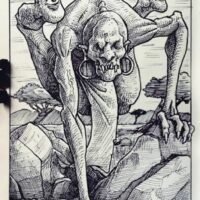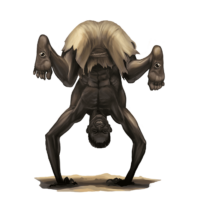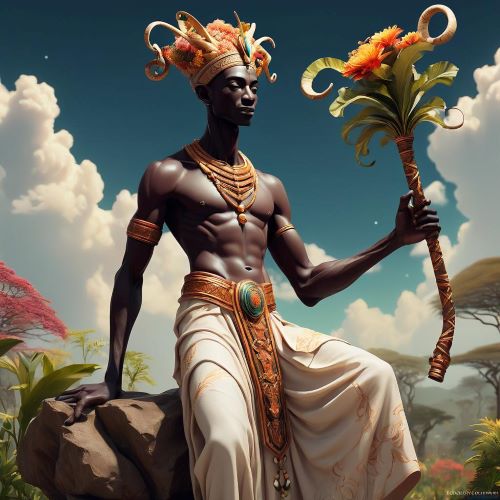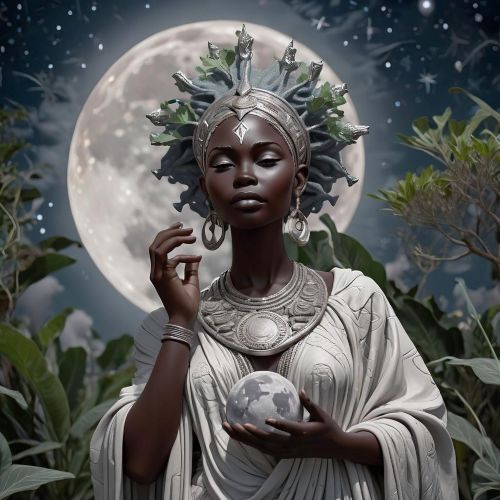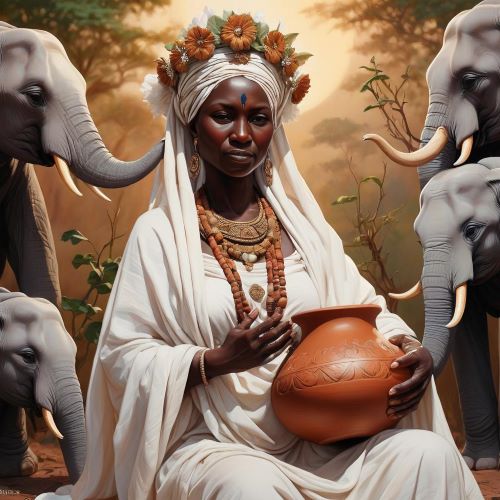Hevioso : God of Thunder
Listen
At a glance
| Description | |
|---|---|
| Origin | Fon Mythology |
| Classification | Gods |
| Family Members | Mawu-Lisa (Parent), Sakpata (Brother) |
| Region | Benin |
| Associated With | Thunder, Lightning, Rain, Fire |
Hevioso
Introduction
Hevioso, also called Sogbo in some regions, is a prominent deity in Fon mythology, revered as the god of thunder, lightning, rain, and fire. He commands the thunder pantheon and enforces cosmic order through divine justice. Believed to be the second-born of Mawu-Lisa—the creator deity embodying both masculine and feminine energies—Hevioso plays a crucial role in maintaining moral balance in the universe. His powers over natural forces and his position as a punisher of wrongdoers establish him as both a fearsome and respected figure among Vodun practitioners in Benin and the African diaspora.
Physical Traits
Hevioso is typically symbolized rather than given a consistent human-like form. His presence is marked by striking imagery—lightning bolts, thunderclaps, and red firestorms. These natural elements serve as his divine language. He is often represented through powerful symbols such as double axes, which signify strength, duality, and judgment. One of the more mystical representations of Hevioso is as a red ram—an animal associated with aggression and fiery force—highlighting his unstoppable nature. In certain traditions, he also embodies androgyny, blending masculine and feminine energies, reflecting his cosmic origin and spiritual balance.
Family
Hevioso belongs to a complex divine family headed by Mawu-Lisa, the god who encompasses both lunar and solar aspects. His siblings include significant deities such as Sakpata, the god of earth and disease, and Gun, the god of iron and war. The stories surrounding Hevioso and Sakpata are especially significant in Fon mythology. In one myth, a bitter dispute between the two leads Hevioso to withhold rain from Sakpata’s territory, resulting in a severe drought. These narratives highlight the delicate balance of natural forces and the impact of divine relationships on human well-being. Some accounts even describe Hevioso and Gun as twins, implying a spiritual and functional connection between thunder and warfare.
Other names
Hevioso is known by multiple names that reflect regional dialects and cultural adaptations. In Fon Vodun, variants like Xevioso, Hebioso, and Heviosso appear, while the name Sogbo emphasizes his kingly aspect within the thunder pantheon. In Yoruba tradition, his closest counterpart is Shango, the god of thunder and drumming, who shares many overlapping characteristics. As African religious practices spread through the diaspora due to the transatlantic slave trade, Hevioso’s identity evolved further. In Caribbean and Latin American spiritual systems, he is often syncretized with Catholic saints such as Saint Barbara or Saint Jerome. These name variants and cultural fusions underscore the enduring adaptability of Hevioso’s mythos.
Powers and Abilities
Hevioso possesses vast control over elemental and spiritual forces. His mastery of thunder and lightning allows him to wield destruction and transformation in equal measure. He is able to summon storms, bring rain to nourish the land, or unleash fire and lightning as retribution against evildoers. One of his most feared abilities is divine judgment—Hevioso is believed to strike down liars, thieves, and those who violate community ethics. His justice is swift and often final, making him a key enforcer of moral order within Vodun theology. Beyond punishment, Hevioso also plays a protective role, safeguarding the innocent and maintaining equilibrium in the cosmos. His erratic thunderous voice is often interpreted as a sign of divine communication or warning.
Modern Day Influence
Hevioso’s legacy continues to thrive in contemporary Vodun practices, particularly in Benin, Togo, and among African diaspora communities. Shrines and altars dedicated to him are visited regularly by devotees seeking rain, protection, or retribution. Ritual items, such as iron axes and red cloths, are used in ceremonies to invoke his energy. His presence is not confined to traditional religion; Hevioso also holds cultural significance in music, dance, and oral storytelling, especially during seasonal festivals when his myths are retold through drumming and performance.
In the Americas, Hevioso—under the guise of Shango or Sogbo—plays a prominent role in Santería, Candomblé, and Haitian Vodou. These faiths integrate African spirituality with colonial-era Catholicism, allowing Hevioso to survive and flourish in new religious landscapes. Hevioso is also gaining attention in global discussions about indigenous spirituality, environmental justice, and African mythology. His attributes of power, balance, and righteous anger resonate with modern ideals of justice and ecological harmony.
Related Images
Source
Mythopedia. (2023, September 25). Sogbo – Mythopedia. Retrieved from https://mythopedia.com/topics/sogbo
eHRAF World Cultures. (2025, March 21). Fon – Summary – eHRAF World Cultures. Retrieved from https://ehrafworldcultures.yale.edu/cultures/fa18/summary
TV Tropes. (2020, December 29). Myth / Gbe Mythology. Retrieved from https://tvtropes.org/pmwiki/pmwiki.php/Myth/GbeMythology
AfricaVodun. (2022, September 28). Dance and Spirituality. Retrieved from https://cid-ds.org/africavodun/
Oxford Reference. (2025, February 1). Mawu and the Earth That Became Unwieldy. Retrieved from https://www.oxfordreference.com/display/10.1093/oi/authority.20110803100141559
Wikipedia contributors. (n.d.). Xevioso. Wikipedia. Retrieved from https://en.wikipedia.org/wiki/Xevioso
Oxford Reference. (n.d.). Sogbo, with Lightning from His Mouth. Retrieved from https://www.oxfordreference.com/display/10.1093/oi/authority.20110803100516401
Mami Wata Healers Society. (n.d.). Heviosso: The Thunder God. Retrieved from https://www.mamiwata.com/heviosso
Frequently Asked Questions
What is lorem Ipsum?
I am text block. Click edit button to change this text. Lorem ipsum dolor sit amet, consectetur adipiscing elit. Ut elit tellus, luctus nec ullamcorper mattis, pulvinar dapibus leo.
What is lorem Ipsum?
I am text block. Click edit button to change this text. Lorem ipsum dolor sit amet, consectetur adipiscing elit. Ut elit tellus, luctus nec ullamcorper mattis, pulvinar dapibus leo.
What is lorem Ipsum?
I am text block. Click edit button to change this text. Lorem ipsum dolor sit amet, consectetur adipiscing elit. Ut elit tellus, luctus nec ullamcorper mattis, pulvinar dapibus leo.
What is lorem Ipsum?
I am text block. Click edit button to change this text. Lorem ipsum dolor sit amet, consectetur adipiscing elit. Ut elit tellus, luctus nec ullamcorper mattis, pulvinar dapibus leo.
What is lorem Ipsum?
I am text block. Click edit button to change this text. Lorem ipsum dolor sit amet, consectetur adipiscing elit. Ut elit tellus, luctus nec ullamcorper mattis, pulvinar dapibus leo.




